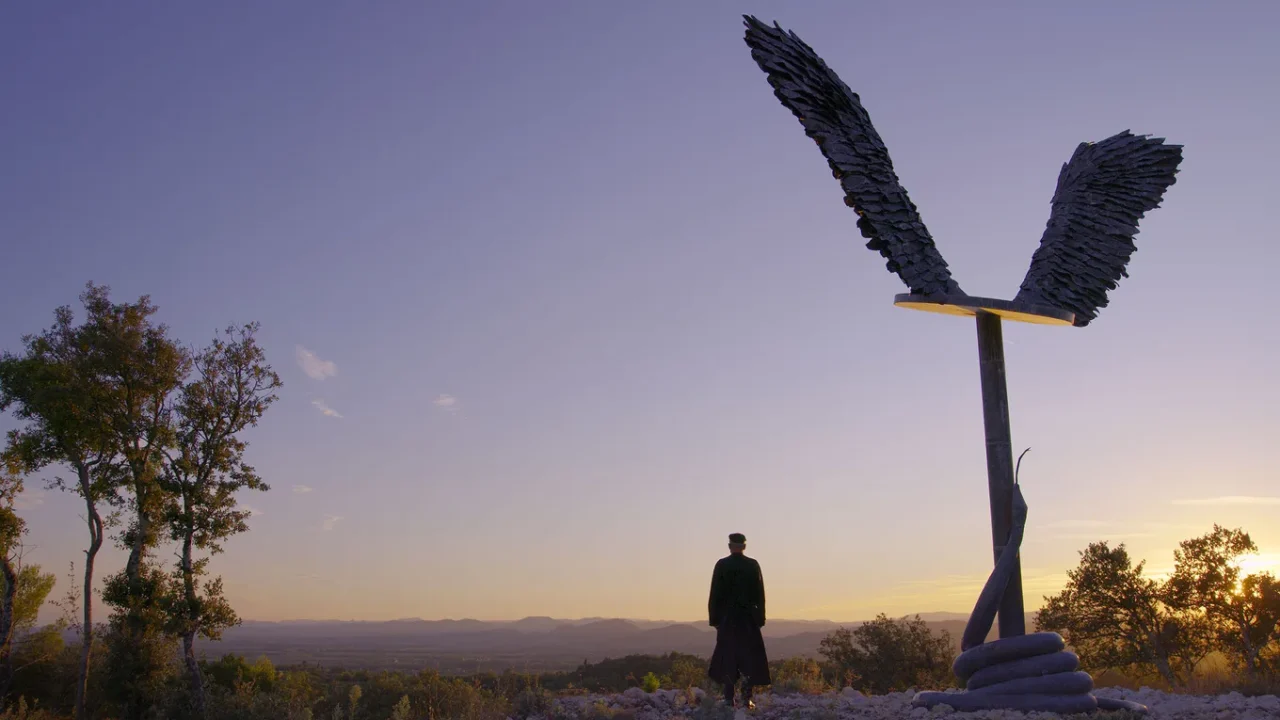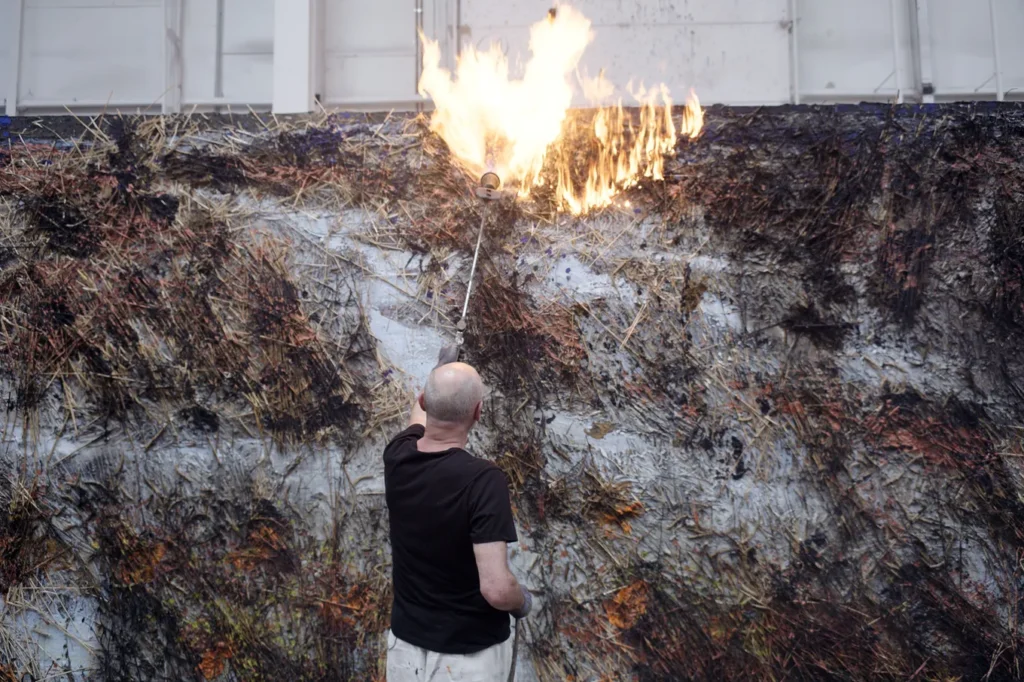A Visual Poetry of Unspeakable Horrors
A new Wim Wenders documentary chronicles the work of controversial sculptor and painter Anselm Kiefer. Anselm Kiefer poses by one of his sculptures. Photo by Franz Lustig courtesy of Road Movies
Anselm Kiefer poses by one of his sculptures. Photo by Franz Lustig courtesy of Road Movies
“Anselm” is not the first time Wim Wenders has made an esoteric documentary about an artist he reveres. Nor is it the first time he’s done so using 3D. But few major directors have ever used the technology to such powerful effect. Anselm Kiefer — who, like Wenders, was born in Germany in 1945 — is a painter and sculptor whose subjects are war and the horrors of the Third Reich. He paints enormous, lifelike fields that include organic materials, such as straw, and then burns them with a blowtorch — since, he says, a landscape can no longer be beautiful once tanks have driven through it. He binds photography books containing his aerial snapshots, smothers them in ash and carefully arranges them as though they’re relics waiting to be found. In “Anselm,” Wenders’ deploys formally inventive camera work to capture the admonition to remember what animates Kiefer’s stark canvases and abstract oddities.
If Wenders’ homage to Ozu Yasujiro from earlier this year, the drama “Perfect Days,” is the director’s most sentimental work, then “Anselm” contends for his most haunting. It begins, as any film about an artist should, with the art in question. The 3D camera cautiously circles sculptures of ornate dresses adorning phantom torsos, accompanied by mournful whispers off-screen, which go hand in hand with composer Leonard Küßner’s heart-rending strings. These invisible women are given form by the absence of their bodies, and the various buildings and astronomical models rising from where their heads ought to be invite curious questions of who they were, or would have been and what they might have brought to the world.
Like Kiefer, Wenders has long constructed his subjects from the traces left in their absence. In his more traditional 1985 documentary about Ozu, “Tokyo Ga,” he interviews the Japanese director’s collaborators and explores the city he loved after the filmmaker’s death. In 2011’s “Pina,” about neo-expressionist choreographer Pina Bausch, he takes a similar approach, but ensures that we learn no biographical facts about Bausch. We come to know the subject only through the work she leaves behind, performed and re-performed by those who loved her.
If Wenders’ homage to Ozu Yasujiro from earlier this year, the drama “Perfect Days,”is the director’s most sentimental work, then “Anselm” contends for his most haunting.
As Wenders’ only other 3D film, “Pina” makes for a fascinating companion piece to “Anselm.” In the former, shot by Hélène Louvart and Jörg Widmer, he uses the technology to re-create the confines of the theater, not only presenting archival footage of Bausch adorned by stage curtains on either side, but creating boundaries and a sense of enclosure even while filming wide open spaces, as though reality is being filtered through Bausch’s imagination.
“Anselm” is its equal and opposite. Shot by Franz Lustig, it also creates borders around some of its images (usually black bars on either side), and, in so doing, pushes the plane of focus, i.e. the image itself, further back than your eyes anticipate. The “screen” as we understand it — the place where the images “happen” — becomes an elusive realm in the distance, an infinite space beyond the fourth wall. The actual, physical screen, meanwhile, becomes an incidental window, rather than a fabric. As the camera sits near the ground, gazing up at Kiefer’s work, elements in the foreground — leaves of grass, for example — appear to protrude, ever-so-slightly, leading off-screen and creating a kind of pathway between the viewer and the image.
Kiefer liked mindful provocations. In a lengthy series of self-portraits of the artist performing the Nazi salute, Kiefer’s work reminded Cold War Germany of the evils it was slowly, perhaps intentionally, forgetting. Such alarm bells-as-reminders have been ringing throughout cinema in 2023; most notably, Jonathan Glazer’s “The Zone of Interest,” releasing in the U.S. later this month, offers a chilling depiction of atrocities taking place just beyond the hum-drum of a Nazi officer’s daily family life.
Although archival newsreels do appear, explaining some of the controversies around Kiefer’s boundary pushing, much of the film follows him in the present day as he quietly creates chilling new pieces through unconventional means: hot metal that bubbles on the canvas, or a black and white landscape created by violent, stabbing brushstrokes.
Wenders also dramatizes vital moments from his artistic development. We see Kiefer as a boy (played by Wenders’ own grandson Anton) and as a man of middle-age (played by Kiefer’s son Daniel) choosing a frigid isolation over community to better hone his skills and develop his vision. In the past and present, the 3D camera makes each of Kiefer’s workshops and warehouses feel vast, and as boundless as the works themselves. Some of these are housed in dilapidated buildings filled with debris, once more calling into question the borders of his work, since these structures echo Jewish ghettos and buildings shelled by artillery, thus becoming the art themselves.

Wenders goes to great lengths to scrutinize these blurry lines by superimposing footage of wartime destruction over specific pieces and spaces. But he isn’t content with merely drawing these often self-evident parallels. Instead, he contrasts swiftly moving shots of Kiefer’s inventory with static archival footage, or close-ups of the fine details of his canvases with aerial snapshots of real devastation, layering these images of past and present atop one another as though they existed simultaneously — as though what we were experiencing were not just images connected through editing, but ideas occupying a metaphysical space. It comes as close as any film can to visualizing the feeling of being on the verge of inspiration.
Wenders films many of Kiefer’s macabre work outdoors, across several sprawling acres of French countryside. The result is a walking installation one imagines being stumbled upon by a future archeologist confronted with Kiefer’s abstract depictions of twentieth-century horrors and ruins made from materials that have been withered, weathered, burnt, collapsed.
Many of Kiefer’s works were inspired by the Jewish Romanian poet Paul Celan and the German author Ingeborg Bachman, who writes of the treachery of the German language when weaponized. At key points in the film, Wenders superimposes drafts of their work, audio of their recitations, and even footage of the two writers. Celan’s poem “Todesfuge,” or “Death Fugue” — which inspired Kiefer’s oil-and-straw painting “Margarethe”— appears pasted to an invisible wall in the distance while the poet’s voice rings out. Later, when the artist walks through an underground passageway, footage of the late Bachman reciting “Exil” appears on the cavernous wall:
I am a dead man who walks
not reported anywhere.
Not for the first time in the film, an unassuming, transitory space becomes a catacomb.
Your support matters…Independent journalism is under threat and overshadowed by heavily funded mainstream media.
You can help level the playing field. Become a member.
Your tax-deductible contribution keeps us digging beneath the headlines to give you thought-provoking, investigative reporting and analysis that unearths what's really happening- without compromise.
Give today to support our courageous, independent journalists.
You need to be a supporter to comment.
There are currently no responses to this article.
Be the first to respond.